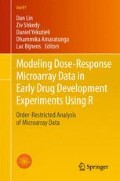Abstract
The development of new and innovative treatments for unmet medical (Barlow et al. 1972) needs is the major challenge in biomedical research. Unfortunately, for the past decade, there has been a steady decline in the number of new therapies reaching the market, despite of the increased investments in pharmaceutical R&D (FDA 2004). One of the most critical steps in a drug discovery program is target identification and validation (Sams-Dodd 2005).
Access this chapter
Tax calculation will be finalised at checkout
Purchases are for personal use only
References
Amaratunga & Cabrera, J. (2003). Exploration and Analysis of DNA Microarray and Protein Array Data, New York: John Wiley
Barlow, R.E., Bartholomew, D.J., Bremner, M.J., & Brunk, H.D. (1972). Statistical inference under order restriction. New York: Wiley.
Butcher, S. (2003). Target discovery and validation in the post-genomic era. Neurochemical Research, 28, 367–377.
Chuang-Stein, C., & Agresti, A. (1997). Tutorial in biostatistics: A review of tests for detecting a monotone dose-response relationship with ordinal response data. Statistics in Medicine, 16, 2599–2618.
Cooke, R.M. (Ed.). (2009). Uncertainty modeling in dose-response. New York: Wiley.
FDA, U. (2004). Innovation or stagnation: Challenge and opportunity on the critical path to new medical products. Silver Spring: US Food and Drug Administation. New York: Wiley
Goehlmann, H., & Talloen, W. (2009). Gene expression studies using Affymetrix microarrays. Boca Raton: Chapman & Hall/CRC. New York: Wiley
Jacqmin, P., Snoeck, E., van Schaick, E., Gieschke, R., Pillai, P., Steimer, J.-L., et al. (2007). Modelling response time profiles in the absence of drug concentrations: Definition and performance evaluation of the KPD model. Journal of Pharmacokinetics and Pharmacodynamics, 34, 57–85.
Jacobs, T., Straetmans, R., Molenberghs, G., Bouwknecht, A., & Bijnens, L. (2010). Latent pharmacokinetic time profile to model dose-response survival data. Journal of Biopharmaceutical Statistics, 20(4), 759–767.
Lengauer, T. (2001). Computational biology at the beginning of the post-genomic era. In Informatics—10 years back. 10 years ahead (Vol. 355). Heidelberg: Springer. New York: Wiley.
Louis, T.A. (2009). Math/Stat perspective in Chapter 2: agreement and disagreement, in Cooke, R.M. (Ed.). (2009). Uncertainty modeling in dose-response. New York: Wiley.
Marton, M., DeRisi, J., Bennett, H., Iyer, V., Meyer, M. Roberts, C., Stoughton, R., Burchard, J., Slade, D., & Dai, H. (1998). Drug target validation and idenfication of secondary drug target effects using DNA microarrays. Nature Medicine, 4, 1293–1301.
Ruberg, S.J. (1995a). Dose response studies. I. Some design considerations. Journal of Biopharmaceutical Statistics, 5(1), 1–14.
Ruberg, S. J. (1995b) Dose response studies. II. Analysis and interpretation. Journal of Biopharmaceutical Statistics, 5(1), 15–42.
Sams-Dodd, F. (2005). Target-based drug discovery: Is something wrong? Drug Discovery Today, 10, 139–147.
Author information
Authors and Affiliations
Corresponding author
Editor information
Editors and Affiliations
Rights and permissions
Copyright information
© 2012 Springer-Verlag Berlin Heidelberg
About this chapter
Cite this chapter
Lin, D., Talloen, W., Bijnens, L., Göhlmann, H.W.H., Amaratunga, D., Straetemans, R. (2012). Introduction. In: Lin, D., Shkedy, Z., Yekutieli, D., Amaratunga, D., Bijnens, L. (eds) Modeling Dose-Response Microarray Data in Early Drug Development Experiments Using R. Use R!. Springer, Berlin, Heidelberg. https://doi.org/10.1007/978-3-642-24007-2_1
Download citation
DOI: https://doi.org/10.1007/978-3-642-24007-2_1
Published:
Publisher Name: Springer, Berlin, Heidelberg
Print ISBN: 978-3-642-24006-5
Online ISBN: 978-3-642-24007-2
eBook Packages: Mathematics and StatisticsMathematics and Statistics (R0)

